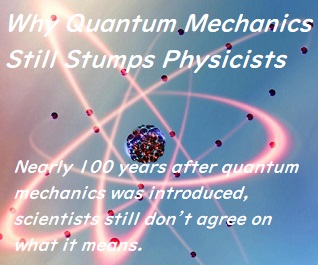
哲学者達の間では次のように考えるのが常に習慣となっている。即ち、因果律(因果法則)(causal laws)は「Aは(が)Bの原因である」という形で言い表わされ、それは、Aなるある一定の種類の事象が起れば(occur)、Bなる特定の種類の事象(event)が続いて起こると解釈される。多くの哲学者は、因果の継起(a causal sequence ひと続きのもの)が、継起の 「不変性」 (invariability) 以上の何ものかを含み、「必然性」 (necessity)と呼べるような何らかの性格をもたなければならない、と考えた。けれども 多くの経験主義者(経験論者)はこれを否定し、そこには不変な継起以外のものは含まれていないと考えた(訳注:「必然性」の否定)。しかし、こういう考え方は全て、もし哲学者が科学にある程度親しんでいれば、維持することはできなかったであろう。 因果律は不変(なもの)ではないか、あるいは傾向のみを述べるか(state only tendencies)、いづれかでなければならない。 古典力学においては、因果律は微分方程式(differential equations)の形をとり、この方程式は、 現実的出 来事でなく、加速度を述べている(訳注:瞬間における加速度の変化は傾向をしめしており、それは微分方程式によって示される)。現代物理学においては、(物理)法則は統計的なものとなっている。それは特定の場合に何が起こるかは述べないが、それぞれが割り当てられた割合で起こる、相異なる事柄を述べるだけである。(訳注:たとえば、量子力学において、電子がどのように動くかは確率的なものになります。)このような理由により、因果律は、古風な哲学者の本の中で述べられていたようなものではもはやない(のである)。 それにもかかわらず、因果関係(causation)は 最も重要な地位を(現在でも)持ち続けている。たとえば、多少とも存続する(持続的に存在する)一つの「物 (thing)」とは何を意味するか考えてみよう。物(もの)とは実際には一連の出来事の集合から成っていると言わなければならない。そしてそれらの各々の出来事の集合は、その「物」の瞬間的状態といってよいものを特徴づけている。異なる時刻における「物」の状態は、常にとは言えなくとも多くの場合、 他の 「物」を引き合いに出すことなしに述べることができる法則によって結び付けられている。もしこの事実がない ならば、科学的知識はいつになっても始まらないだろう(生まれないであろう)。 全てのことを知ることなしに何かを知ることができないならば、我々(人間)は何かをしることは決してきないことは明らかである。このことは、個々の出来事についてだけでなく、出来事を結びつける法則についても当てはまる。 物理学において、原子や分子はある時間存続しており、そうして、もし存続しないとしたら、運動の概念は無意味となるであろう。人間の身体(ひとかたまり)もある時間存続するが、身体をつくっている原子や分子は常に同一ではない。星から人間の眼に移動する一個の光子(フォトン)は、その移動の間 存続しているのであり、もしそうでないなら、 星を見るということの意味が何であるかを我々は述べることはできないであろう。しかしこの種の持続(存続)は全て通常の (usual) こと(よくあること)にすぎず、不変 (in variable) なものではない。そして科学の出発点となる因果律は、通常起ることの近似値を述べているにすぎないはずである。 最終的に何かもっと精確な法則が得られるものなのかどうか、我々(人間)にはわかならい。我々が主張できると私が考えるのは、次のようなものである。つまり、任意の(与えられた)事象が与えられると、その近接した時刻において、かつその近接した場所において、その与えられた事象とよく似た事象が、通常存在する。 また、その事象と、先の与えられた事象との間の 小さな相違を近似的に決定する何らかの法則を発見することが、たいていの場合、可能である。 何らかのそういった原理が、多くの「物」の近似的な持続性を説明するために必要であり、またAを知覚することとBを知覚することの相違 ―たとえばAとBとがともに星であって両者を我々が見ているような場合 -を説明するためにも必要なのである。 ある事象の系のどの一つ事象からでもそれに近接して起る事象について何らかのことが推論できるという特性(property 属性)を持つ時、そのような事象の系を私は「因果の線」 (causal line)と名づける。 「物」の概念を常識にとって有用なものたらしめ、「物質」の概念を科学にとって有用なものたらしめたのは、上のような因果線が存在するという事実なのである。また現代物理学をし 「物質」の概念を不十分と考えしめるにいたったものは、上のような因果線が近似的であり、不変 でなく、普遍的でない、という事実なのである。
Chapter 16: Non-Demonstrative Inference , n.10 It used to be the custom among philosophers to think that causal laws can be stated in the form ‘A causes B’, interpreted as meaning that whenever an event of a certain kind A occurs, it is followed by an event of another specified kind, B. It was held by many that a causal sequence involves something more than invariability and must have some character that can be called ‘necessity’. Many empiricists, however, denied this and thought that nothing was involved except invariable sequence. This whole point of view, however, could never have persisted among philosophers if they had had any acquaintance with science. Causal laws must be either not invariable or such as state only tendencies. In classical dynamics they take the form of differential equations, stating acceleration, not actual occurrences. In modern physics the laws have become statistical: they do not state what will happen in any particular case, but only different things, each of which will happen in an assigned proportion of cases. For such reasons, causation is no longer what it used to be in the books of old-fashioned philosophers. Nevertheless, it still retains an essential place. Take, for example, what we mean by a single ‘thing’ which is more or less persistent. This ‘thing’ must really consist of a series of sets of occurrences, each set characterizing what we may call a momentary state of the ‘thing’. The states of the ‘thing’ at different times are, often, though not always, connected by means of laws which can be stated without mentioning other ‘things’. If this were not the case, scientific knowledge could never get a start. Unless we can know something without knowing everything, it is obvious that we can never know something. And this applies, not only to particular events, but also to the laws connecting events. In physics, atoms and molecules persist for a time, and, if they did not, the conception of motion would become meaningless. A human body persists for a time, although the atoms and molecules of which it is composed are not always the same. A photon which travels from a star to a human eye persists throughout its journey, and, if it did not, we should not be able to state what we mean by seeing a star. But all these kinds of persistence are only usual, not invariable, and the causal laws with which science begins must state only an approximation to what usually happens. Whether, in the end, something more exact is attainable, we do not know. What I think we can say is something like this: given any event, there is usually, at any neighbouring time and in some neighbouring place, an event very like the given event; and, as a rule, it is possible to discover some law approximately determining its small difference from the given event. Some such principle is necessary to explain the approximate persistence of many ‘things’, and also to explain the difference between perceiving A and perceiving B – for example, if A and B are stars, both of which we are seeing. I give the name of ‘causal line’ to a series of events having the property that from any one of them something can be inferred as to neighbouring events in the series. It is the fact that such causal lines exist which has made the conception of ‘things’ useful to common sense, and the conception of ‘matter’ useful to physics. It is the fact that such causal lines are approximate, impermanent, and not universal which has caused modem physics to regard the conception of ‘matter’ as unsatisfactory.
Source: My Philosophical Development, 1959, by Bertrand Russell
More info. https://russell-j.com/beginner/BR_MPD_16-100.HTM
